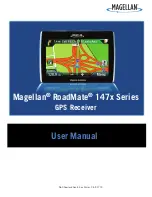
Page 18
(pin 2) of the 12CA5 output tube with a screwdriver that is held in contact with your finger. A low level hum should be
heard. Move the screwdriver to the grid of the 12AX7 tube section B (pin 2) and then to the grid of section A (pin 7). The
hum or noise should become louder with each stage. If no sound is heard, look for trouble in that particular stage.
CAUTION: To avoid any shock hazard when making the above test, make sure that only the pins that are mentioned in
the text are touched with the screwdriver, and the other hand or any other part of the body is not in con-tact with the
chassis pr any other conductor that may provide a return path to ground.
If after careful checks the trouble is still not located, check voltage and resistance readings found on the schematic
diagram. Note: All
voltage and resistance readings were taken with a Heathkit Vacuum Tube Volt Meter. Voltage and
resistance readings may vary 20%
due to line voltage variations and the tolerance of components. A reading that is off more
than 20% would indicate probable trouble in
that particular stage. A review of the circuit description may also be helpful
in indicating where to look for the trouble. NOTE: In an
extreme case where you are unable to resolve a difficulty, refer to
the "Customer Service" information inside the rear cover of the
Manual. Your Warranty is inside the front cover.
USING THE SIGNAL TRACER
The IT-12 Signal Tracer is one of the simplest, yet most effective instruments the service tech-nician can use for rapid,
accurate trouble-shooting in radio and TV circuits. The tracer is of the untuned type to simplify operation thus holding
control manipulation to an absolute minimum.
This instrument features a number of useful applications which will enable the service technician to quickly locate and
diagnose the trouble in the circuit under test. Many of the tests will be performed automatically, and will require only a
few seconds of the technician's time. It is suggested however, that the user familiarize himself with all phases of the
instrument's operation, so that maximum benefit can be realized from the investment in the kit.
The procedures to be followed when using the Signal Tracer are outlined in a general manner only, and do not represent
the limits of its applications. Each individual will develop his own procedures and applications by using the instrument.
RF Signal Tracing
To use the Signal Tracer for RF signal tracing, the probe switch should be in the RF position, the off "on switch and the
speaker switch to the ON position, and the noise switch to OFF. The level control should be adjusted as needed. In some
cases it may be desirable to turn off the speaker and observe the approximate signal level on the indicator tube. Note: At
near maximum settings of the level control a certain amount of hum will be present; this is due to the high sensitivity of
the unit and the fact that the input grid has been extended to the probe permitting it to pick up spurious AC fields.
To illustrate the use of this instrument, a typical radio schematic is presented so the test points may be clearly pointed out.
Let us assume that the receiver under test has a specific complaint of low volume. Since the receiver is in partial operating
condition, it could be turned on and tuned to a familiar station. The volume control should be turned down so that the-
speaker out-put will not interfere with the signal tracer results. The flexible ground lead of the probe should be clipped to
the B- or ground circuit of the receiver.
If the receiver is tuned to a strong station, and the probe connected, a signal should be present at the loop antenna, the
tuning condenser and at the grid (pin 7) of tube A. When the probe is moved to the plate, (pin 5 of tube A) a substantial
increase in signal should be observed. Note: At radio frequencies, the D. C. voltages used in the IF stages need not be
filtered 100%. Coupled with this fact, the signal at the mixer or converter plate (pin 5) is very weak and requires a high
Содержание IT-12
Страница 1: ......
Страница 4: ...Page 2 ...
Страница 25: ...Page 23 ...
Страница 26: ...Page 24 ...
Страница 27: ...Page 25 ...
Страница 28: ...Page 26 ...
Страница 30: ......










































